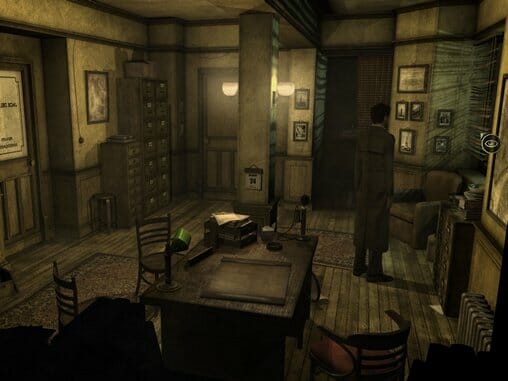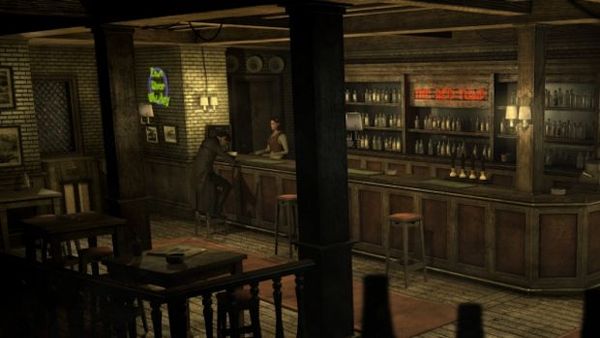Face Noir (PC)

Ok, so let’s get this out of the way: every time I read the phrase “Face Noir”, I read it as “blackface”. This is a problem. And it’s not the only weird racial thing going on in this game about Jack Del Nero, Italian immigrant to New York City, ex-cop, current private detective. He swears in Italian. He fits very well in a Great Depression era Noir York City, soundtracked by jazz and full of the downtrodden and despondent. Corruption at the top of the chain—basic survival at the bottom. No American Dream in noir: they hang you by your bootstraps.
Noir cinema was fatalistic in a way a lot of other cinema at the time was not: The protagonist struggled, but it didn’t matter. There was no triumph of the individual, no marital or financial success. Sometimes they died in the first five minutes, the rest of the story told in flashback, all their actions futile because, as the audience knows, they’re doomed. Their struggle against an uncaring system, at best, results in a narratively incongruous happy ending.
Del Nero’s dreams aren’t the American. They’re (playable) flashbacks to events from earlier in the day, events Del Nero was not present for. And yet they provide him with accurate information. It’s a hint that maybe the noirish conspiracy Del Nero has stumbled into isn’t entirely rational.
Noir-as-fatalism (as opposed to noir-as-fedoras) should be a good fit for games, especially the relationship of players who want as much agency as possible to the limited and limiting systems of code, bound by a screen and an interface.
Point-and-clicks are one of the most accessible PC game interfaces—since they just involve moving the mouse around the screen and clicking on objects, there’s not any special skill required beyond what it takes to use most any computer. You just have to be able to figure out what you can click on. Face Noir’s cursor changes when hovering over something to interact with. Pressing F1 (or hitting a clickable button on the top of the screen, if you’re playing with just the mouse) will show you all the hotspots onscreen where you can click. As long as you’re not looking close up at an object, when it will tell you that that would make it too easy.
Taking the guesswork out of what’s clickable is nice because it relieves one of the frustrating issues point-and-clicks have: Your forward progress might be impeded because you missed clicking on one thing you didn’t see. Of course, your forward progress is impeded often by not having clicked on the right thing yet, but Del Nero’s refusal to go where you don’t need to and the hotspot indicator mean you can usually systematically go through each area and hit everything until something works. All the information you need to solve the crime is accessible in the game—its job isn’t to stump you indefinitely, it’s just supposed to lose gracefully.
That technique fits well with how some film detectives work. Not the Sherlock Holmes detective, but the detective of American pulp. The detective whose forward progress is based on tenacity rather than deep knowledge. Who can move around easily, from boardrooms to brothels without needing any disguise—movement that acknowledges class divides in America while still providing a fantasy of being able to transcend them, if only temporarily.
Movement in-game is easy: You click, Del Nero walks. There’s no need to learn how to navigate the space of the game, and it helps keep a separation between you as the player and Del Nero as the character. He’s in the world, you’re just looking at it—something that is all too clear when you realize how quickly your mouse cursor moves across the screen as you wait for him to walk to wherever you’ve clicked. This gets extra frustrating whenever he needs to sneak past some cops. But you can get some revenge: He stands around waiting for you to tell him what to do, occasionally muttering clues to himself and only interacting with what is necessary.
There are plenty of things you can click on that Del Nero doesn’t need to interact with. There are clickable piles of trash around the city, but Del Nero wants nothing to do with them. He’ll describe them, slightly disgusted, and refuse to dig through them—unless there’s something in them that the story says he needs. While you’re not gathering information from them, or solving puzzles involving them, the trash being clickable keeps it from fading into the background, like each individual brick on a wall. Trash is crucial to this New York.
Sometimes there’s burglary: A lockpicking minigame requires you to move the pick around in a circle until you hear a sound. No visual cues, but an option to skip appears after a bit of fumbling. A later safe-cracking bit also requires listening to audio cues, but I couldn’t get the “skip” option to show up.
